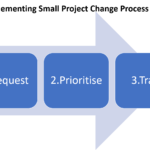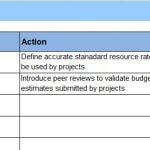Following on in the series on how to identify and manage small change projects. The activity that falls between Business as Usual (BAU) and change. See “How to provide visibility and reporting for small change projects“.
One of the first challenges many people experience is how to know what is a small change project. I have seen many hours, days and even months wasted debating if an item is BAU or change. This is all time that is lost doing meaningful work. Even worse, in many cases the time spent debating this is longer than what time it would take to complete the work!
Given the challenge and potential impact. It is important to define a sensible criteria for defining small change projects.
While there is no definitive rule or criteria to define a small project, the following are ideas that can be used as the foundation for creating the rules and criteria. However, before going into possible measures, it is worth spending a brief moment on an important principle.
- Keep it simple – complex rules and criteria will be difficult to use and apply
With this principle in mind, the following are potential measures that you can use.
Effort
This is a very simple yet effective method. You can define any activity as small change if it sits below a predefined level of effort.
For example you could define that anything that is under 20 days effort is small change.
To make this work, you need to have a mechanism to quickly estimate the effort for a change that balances a level of accuracy with speed. You do not want to spend 10 days estimating a piece of work that will take 20 days.
While the nature of small change is that it is usually best placed to be worked on by 1 person, if you allocate 2 resources, this will then mean the combined effort is 20 days of the 2 resources i.e. 10 days effort each.
Duration
This is a variation on Effort. You again will need to estimate potential effort. However in this case you will allocate a duration of time for the activity.
For example, you may define small change is anything that can be completed in 20 days duration. This means that the change must be completed within 20 days of starting. A bit like an agile sprint.
Financial
Instead of using effort as the measure, you may wish to use a financial measure. For example, the small change must cost less than $10,000.
This can be a good option where work can be executed in low cost locations. The lower day rate may mean that you can utilise more days of effort.
However, it important that the threshold is set so that only small change is completed and not larger projects. Plus it does add the complexity of having to know different day rates based on resource mix / location.
Nature of Change
While the other measures use a tangible measure, using nature of change is more subjective. This relies on someone making an expert judgement on the classification of change.
For example, simple change to existing report may be deemed small change. Where as complex change to new report may be considered a change project.
The theory being simple change to an existing tool or process should be easier. Therefore, more likely it will take less time.
Layering Criteria
While it is possible to use each of the criteria on their own to define small change projects, you can also layer the criteria to make the definition really clear. This is where you combine 2 or more of the measures.
For example, enhancements to existing reports that will take less than 15 days effort. This uses Nature of Change by defining only existing reports and Effort.
However, remember to keep the logic simple.
Additional Considerations
As the approach to defining small change projects relies on being able to quickly estimate effort, it is important to apply a tolerance. For example, what do you do if the definition is effort less than 20 days and the enhancement takes 21?
This is where you need to be pragmatic and allow a level of tolerance for the work. If not you could waste valuable time debating if work should continue.
Summary
Defining the criteria for small change projects is not an exact science. However, it is important to define a framework that is easy to use and understand so as to quickly categorise small change.
You must be prepared to be flexible and, like with most things in life, you will get better at estimating and making judgement calls over time.






